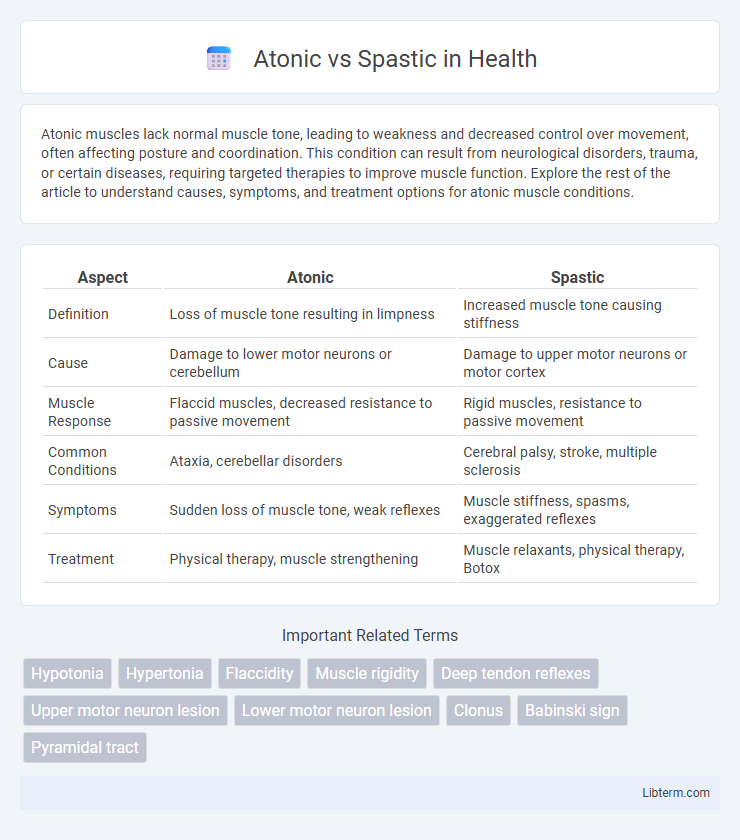Atonic muscles lack normal muscle tone, leading to weakness and decreased control over movement, often affecting posture and coordination. This condition can result from neurological disorders, trauma, or certain diseases, requiring targeted therapies to improve muscle function. Explore the rest of the article to understand causes, symptoms, and treatment options for atonic muscle conditions.
Table of Comparison
| Aspect | Atonic | Spastic |
|---|---|---|
| Definition | Loss of muscle tone resulting in limpness | Increased muscle tone causing stiffness |
| Cause | Damage to lower motor neurons or cerebellum | Damage to upper motor neurons or motor cortex |
| Muscle Response | Flaccid muscles, decreased resistance to passive movement | Rigid muscles, resistance to passive movement |
| Common Conditions | Ataxia, cerebellar disorders | Cerebral palsy, stroke, multiple sclerosis |
| Symptoms | Sudden loss of muscle tone, weak reflexes | Muscle stiffness, spasms, exaggerated reflexes |
| Treatment | Physical therapy, muscle strengthening | Muscle relaxants, physical therapy, Botox |
Introduction to Muscle Tone Disorders
Muscle tone disorders encompass conditions characterized by abnormal muscle stiffness or flaccidity, significantly impacting movement and posture. Atonic muscles present diminished or absent tone, resulting in weakness and poor motor control, while spastic muscles exhibit excessive tone causing rigidity and involuntary spasms. Understanding the distinct features of atonic versus spastic muscle tone is essential for accurate diagnosis and effective therapeutic interventions.
Defining Atonic and Spastic Conditions
Atonic conditions are characterized by a loss of muscle tone resulting in flaccid, weak muscles that fail to contract properly, often causing sudden muscle relaxation and limb collapse. Spastic conditions involve increased muscle tone and stiffness, leading to involuntary muscle contractions, hyperreflexia, and restricted movement commonly seen in disorders like cerebral palsy and multiple sclerosis. Distinguishing between atonic and spastic symptoms is crucial for accurate diagnosis and targeted treatment in neuromuscular disorders.
Causes of Atonic vs Spastic Muscle Tone
Atonic muscle tone results from damage to lower motor neurons or muscle fibers, often caused by spinal cord injuries, peripheral neuropathies, or certain neurodegenerative diseases. Spastic muscle tone arises due to lesions in the upper motor neurons or corticospinal tract, commonly linked to cerebral palsy, stroke, multiple sclerosis, or traumatic brain injury. Understanding the distinct neural pathways involved helps in diagnosing and treating the underlying causes of atonic and spastic muscle tone abnormalities.
Clinical Symptoms and Signs
Atonic seizures present with sudden loss of muscle tone causing abrupt falls or head drops, often leading to injuries due to the rapid collapse. Spastic seizures are characterized by sustained muscle contractions resulting in stiffening and jerking movements, predominantly affecting the limbs. Clinical evaluation differentiates these based on muscle tone changes: hypotonia in atonic versus hypertonia in spastic seizures.
Diagnostic Methods
Diagnostic methods for distinguishing atonic versus spastic conditions primarily involve clinical neurological examinations assessing muscle tone, reflexes, and motor responses. Electromyography (EMG) and nerve conduction studies provide detailed insights into muscle activity and nerve function, helping identify the presence of spasticity or atonia. Advanced imaging techniques such as MRI or CT scans are often employed to detect underlying neurological lesions or brain abnormalities contributing to these motor disorders.
Impact on Daily Function and Mobility
Atonic conditions cause muscle weakness and lack of muscle tone, severely impairing balance and coordination, which limits the ability to perform everyday tasks such as walking, standing, or holding objects. Spasticity results in increased muscle stiffness and involuntary contractions, leading to restricted joint movement and difficulties with fine motor skills and mobility. Both conditions significantly affect daily function, but spasticity often causes more persistent spasm-related pain and mobility limitations, while atonic muscles primarily hinder strength and stability.
Treatment and Management Strategies
Atonic seizures require immediate safety measures due to sudden muscle weakness and typically benefit from treatments like valproate or ethosuximide, alongside protective helmets to prevent injury. Spastic seizures, characterized by muscle stiffness and spasms, are managed with anticonvulsants such as baclofen or diazepam, combined with physical therapy to improve mobility and reduce muscle rigidity. Both conditions demand individualized treatment plans incorporating medication, supportive therapies, and regular monitoring to optimize patient outcomes.
Rehabilitation Approaches
Rehabilitation approaches for atonic and spastic conditions differ significantly due to their opposite muscle tone characteristics. Atonic rehabilitation emphasizes muscle strengthening, use of supportive devices, and neuromuscular electrical stimulation to improve muscle activation and prevent joint instability. Spastic rehabilitation prioritizes muscle stretching, spasticity reduction techniques such as botulinum toxin injections, and functional training to enhance motor control and reduce abnormal muscle stiffness.
Prognosis and Long-Term Outcomes
Atonic cerebral palsy typically results in muscle weakness and poor muscle tone, leading to challenges in mobility and balance, but with targeted physical therapy and supportive interventions, many patients achieve improved motor function over time. Spastic cerebral palsy, characterized by increased muscle tone and stiffness, often results in more persistent functional impairments, including joint contractures and mobility limitations, though early intervention with spasticity management and orthotic support can enhance long-term outcomes. Prognosis for both types varies widely depending on severity and associated complications, emphasizing the importance of individualized treatment plans for optimizing quality of life and functional independence.
Key Differences: Atonic vs Spastic Disorders
Atonic disorders are characterized by sudden loss of muscle tone leading to limp, floppy limbs, whereas spastic disorders involve increased muscle tone causing stiffness and exaggerated reflexes. Atonic conditions primarily affect muscle relaxation and control, resulting in weakness and falls, while spastic conditions cause rigid muscles and difficulty with voluntary movements. Understanding these differences is crucial for accurate diagnosis and targeted therapies in neurological and muscular disorders.
Atonic Infographic

 libterm.com
libterm.com